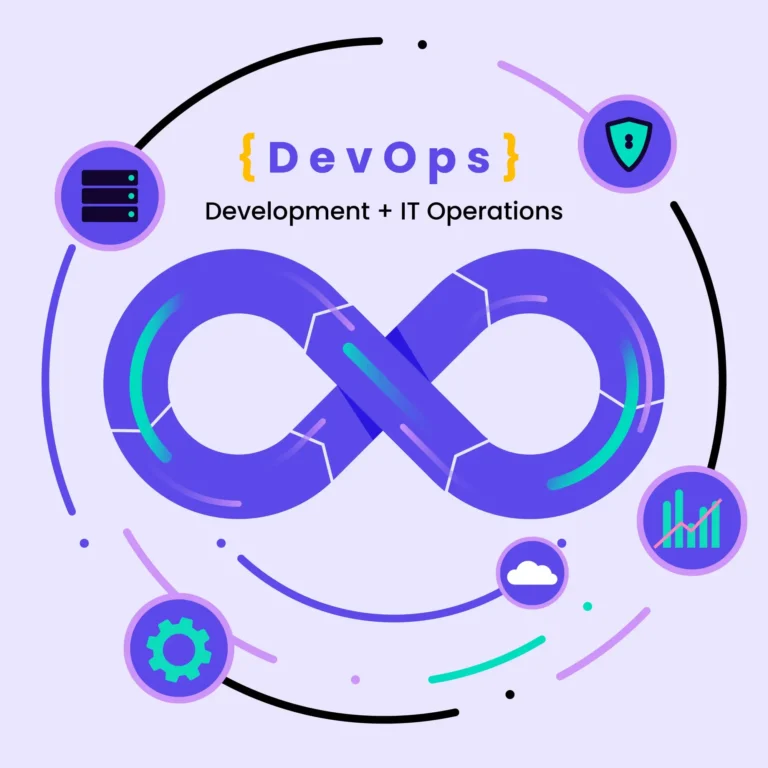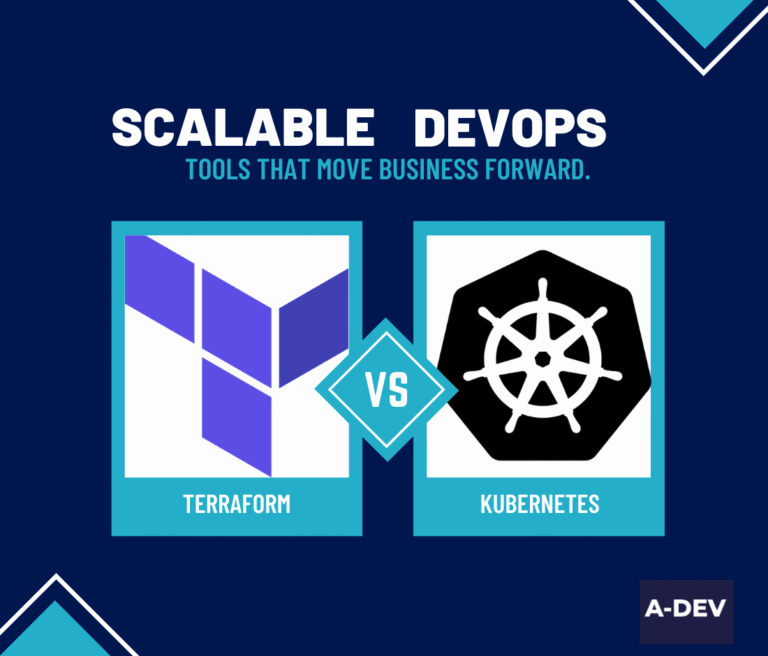Feeling frustrated with slow software delivery cycles and unreliable deployments? Struggling with the disconnect between development and operations teams? If you answered yes, then DevOps might be the answer you’ve been looking for, and this is your roadmap to navigate it successfully.
DevOps is a rapidly growing field that bridges the gap between development (dev) and operations (ops) teams. It’s a philosophy and a set of practices that emphasizes collaboration, automation, and continuous improvement throughout the entire software development lifecycle (SDLC), also sometimes referred to as the DevOps lifecycle.
This comprehensive guide serves as your DevOps roadmap, equipping you with the technical skills and cultural mindset needed to thrive in DevOps. Whether you’re a seasoned developer or operations professional, this roadmap will empower you to contribute to a more efficient and collaborative software development process.
Understanding DevOps: The Foundation for Development and Operations Teams
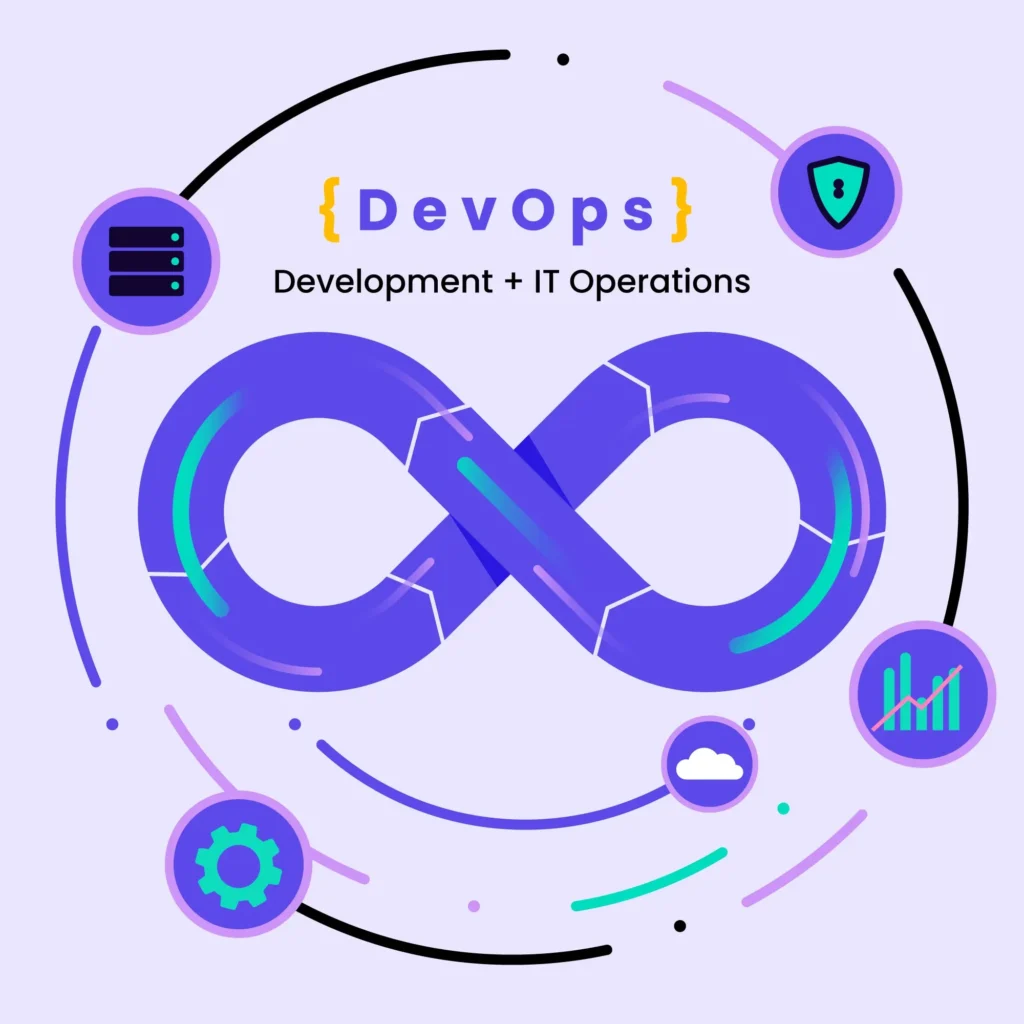
Source: Freepik
Having a solid grasp of the core principles of DevOps is crucial before diving into the technical aspects. It’s more than just tools and automation; it’s about fostering a cultural shift that emphasizes collaboration and shared responsibility between development and operations (DevOps) teams throughout the DevOps lifecycle.
This section will explore the foundational pillars that bridge the gap between these traditionally separate teams:
Continuous Integration (CI): A Pillar of DevOps
Imagine a development team constantly pushing code changes, making it difficult for operations to keep up and ensure a stable environment. This is a common challenge in siloed development and operations workflows. Continuous Integration (CI) solves this by automating the process of integrating code changes from multiple developers into a central repository frequently.
Here’s how continuous integration benefits delivery teams:
- Early identification and resolution of bugs through frequent integration.
- Improved code quality and stability.
- Faster feedback loops between development and operations.
Continuous Delivery (CD): Streamlining Software Delivery
Traditionally, deploying new software updates could be a slow and manual process, leading to bottlenecks and delays. Continuous Delivery (CD) addresses this by automating the deployment process, allowing for frequent and reliable releases of software updates.
Think of CI/CD as a pipeline. CI automates the build and testing stages, while CD automates the deployment process. This allows for faster delivery of features and bug fixes to users.
Infrastructure as Code (IaC): Automating Infrastructure Management
Managing infrastructure (servers, networks, etc.) can be a complex and time-consuming task, especially in environments with frequent changes. Infrastructure as Code (IaC) treats infrastructure as code, allowing for automation and configuration consistency.
With IaC, infrastructure can be provisioned and managed using tools like Terraform or Ansible. This approach brings several advantages to a DevOps engineer:
- Reduced manual errors and improved repeatability.
- Easier configuration management across different environments.
- Faster infrastructure provisioning and scaling.
Monitoring and Observability: Keeping Your Applications Healthy
Applications and infrastructure need constant monitoring to maintain optimal performance and identify potential issues. Monitoring and Observability involve collecting data on application health, performance metrics, and infrastructure logs.
DevOps engineers leverage tools like Prometheus and Grafana to gain real-time insights into system health and identify potential problems before they impact users. This proactive approach ensures application stability and a smooth user experience.
By understanding these foundational principles, you’ll gain a solid foundation for building your DevOps skillset and fostering collaboration between development and operations teams.
Building Your DevOps Skillset: From Beginner to Advanced DevOps Engineer
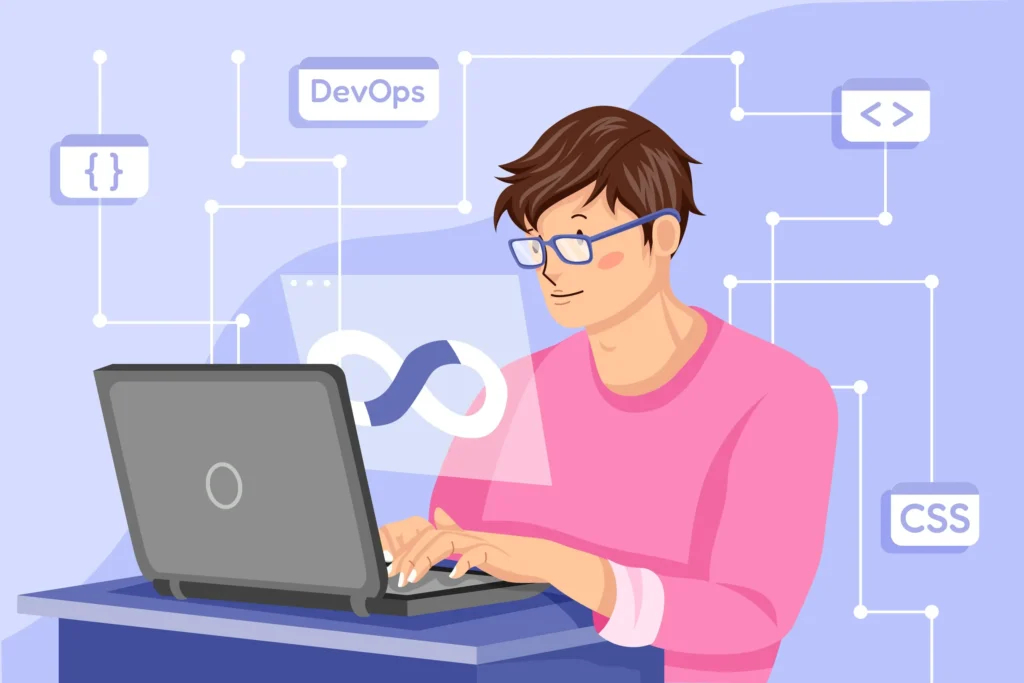
Source: Freepik
The path to becoming a DevOps engineer is paved with continuous learning and skill development. This section serves as your guide, equipping you with the essential skillset needed to navigate the exciting world of DevOps and contribute to reliable software delivery. Remember, DevOps is not just about technical prowess; it’s also about embracing a cultural and collaborative mindset that fosters communication and shared responsibility between development and operations (DevOps) teams.
Mastering the Foundation: Operating Systems and the Command Line
Your journey begins with a solid understanding of operating systems (OS). While some DevOps roles may have a Linux focus, grasping core OS concepts is crucial for interacting with various systems and infrastructure. Learn basic commands for navigating directories, manipulating files, and managing processes. The command line (CLI) might seem intimidating at first, but it simplifies tasks and automates repetitive actions, becoming a powerful tool in your DevOps arsenal.
Version Control Systems (VCS): Mastering Git for Collaboration
Imagine a development team working on the same codebase without proper version control, leading to chaos and confusion. Version Control Systems (VCS), like Git, are essential for managing source code effectively. Git allows you to track changes, collaborate with other developers, and revert to previous versions seamlessly. Mastering Git commands like clone, branch, merge, and pull request will be fundamental for managing your code throughout the software creation process.
CI/CD Tools: Automating Your DevOps Pipeline
DevOps practices leverage automation to streamline software delivery. CI/CD tools automate the build, test, and deployment stages within your delivery pipeline. Popular platforms like Jenkins, GitLab CI/CD, or Azure DevOps Services integrate seamlessly with various development and deployment tools. This allows you to automate tasks like code compilation, unit testing, and infrastructure provisioning. By learning these tools, you gain the power to build a robust and efficient delivery pipeline.
Scripting Languages: Scripting Your Way to Efficiency
While not every DevOps engineer needs to be a programming guru, familiarity with scripting languages like Python, Bash, or PowerShell significantly enhances your automation capabilities. These languages allow you to write scripts for various tasks, from automating infrastructure configuration management to data processing and log analysis. Learning basic scripting empowers you to automate repetitive tasks, saving time and minimizing errors.
Cloud Technologies: Embracing the Cloud for DevOps
Cloud computing has revolutionized software development and deployment. Understanding popular cloud providers like Amazon Web Services (AWS), Microsoft Azure, or Google Cloud Platform (GCP) is becoming increasingly important for DevOps engineers. These platforms offer a wide range of cloud services (storage, compute, databases, etc.) that can be leveraged to build, deploy, and manage applications. Studying cloud design patterns will further enhance your ability to design and deploy scalable and cost-effective cloud infrastructure.
Containerization: Building Portable Applications with Docker and Kubernetes
Containerization has become a cornerstone of modern DevOps practices. Containerization allows you to package applications with all their dependencies into a lightweight, portable unit called a container. Tools like Docker provide a standardized way to build and manage containers, ensuring consistent deployments across different environments. Kubernetes takes containerization a step further, enabling orchestration and management of containerized applications at scale. Mastering these technologies allows you to build and deploy portable applications that run reliably across different environments.
Infrastructure Monitoring and Observability: Keeping Your Eyes on the Prize
Applications and infrastructure require constant monitoring to maintain optimal performance and identify potential issues before they impact users. Infrastructure monitoring involves collecting data on server health, resource utilization, and network performance. Observability goes a step further, allowing you to gain deeper insights into application behavior and identify the root cause of issues. Tools like Prometheus and Grafana provide real-time dashboards and visualizations, enabling DevOps engineers to proactively address problems and ensure a smooth user experience. Understanding these concepts equips you to monitor and maintain the health of your applications and infrastructure.
Beyond the Basics: Continuous Learning and Skill Development
The world of DevOps is constantly evolving, and continuous learning is a key part of a successful DevOps career roadmap. Here are some additional areas to consider for further skill development:
- Networking Security: Review networking security principles and best practices to secure your applications and infrastructure.
- Learn Cloud Design Patterns: Deepen your understanding of cloud design patterns for building scalable and efficient cloud infrastructure.
- Programming Languages: Consider learning a general-purpose programming language like Python or Java to expand your automation capabilities and tackle more complex scripting tasks.
- Study Operating Systems: While a basic understanding of operating systems is essential, consider delving deeper into specific operating systems (e.g., Linux distributions) commonly used in DevOps environments.
- Integrate Databases: To enhance your DevOps skillset, consider integrating databases with your applications and IaC tools. This combined approach promotes efficient infrastructure management.
Developing a DevOps Mindset: Collaboration and Communication
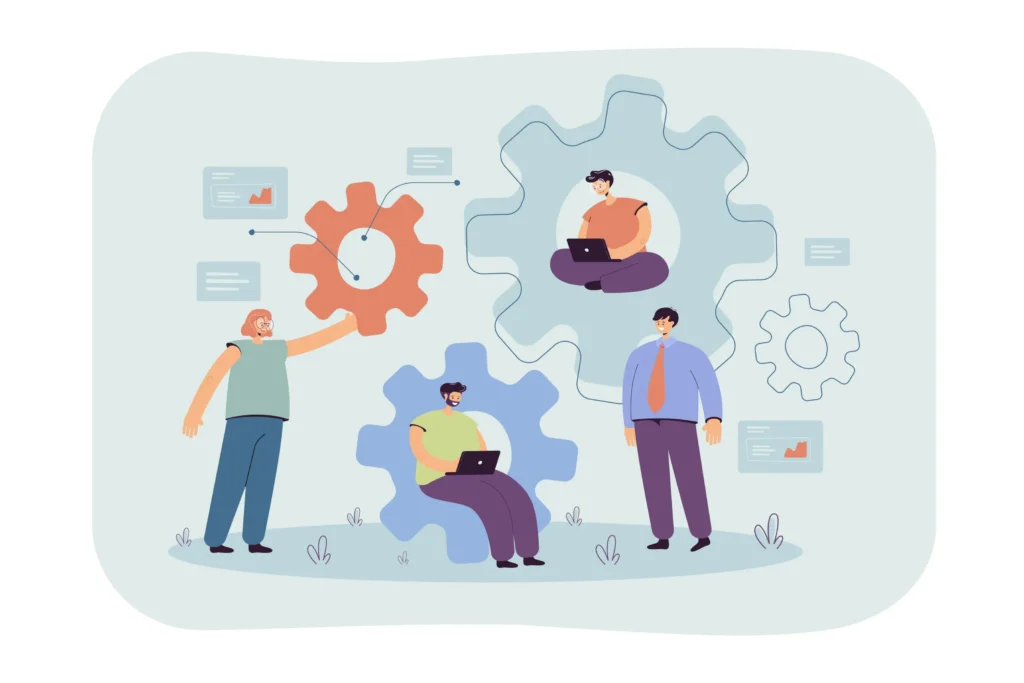
Source: Freepik
While technical skills are crucial, a successful DevOps engineer thrives in a collaborative environment. DevOps emphasizes communication and shared responsibility between development and operations teams. Here are some key aspects to cultivate:
- Collaborative Mindset: Embrace a collaborative approach, actively participate in team discussions, and be open to feedback from other team members.
- Communication Skills: Develop strong communication skills to effectively explain technical concepts to both technical and non-technical audiences.
- Problem-Solving Skills: Approach challenges with a problem-solving mindset, analyze data, and identify root causes of issues.
- Continuous Learning: Maintain a growth mindset and continuously seek out new learning opportunities to stay up-to-date with the latest DevOps trends and technologies.
Building Your DevOps Toolset: A Diverse Technology Stack
The specific DevOps toolset can vary depending on the organization and project requirements. However, familiarity with some of the following tools will enhance your DevOps skillset:
- Configuration Management Tools: Tools like Ansible or Chef automate infrastructure provisioning and configuration management, ensuring consistency across your environments.
- Monitoring Tools: Explore tools like Prometheus, Grafana, or Datadog to monitor application performance, infrastructure health, and identify potential issues proactively.
- Reverse Proxy Load Balancers: Understand how tools like Nginx or HAProxy can distribute traffic across multiple servers for improved scalability and fault tolerance.
- Team Communication Tools: Utilize collaboration platforms like Slack or Microsoft Teams to facilitate communication and information sharing within your DevOps team.
Continuous Improvement: Refining Your DevOps Workflow
DevOps is a journey of continuous improvement. Regularly evaluate your delivery workflow and identify areas for optimization. Here are some strategies to consider:
- Automate More: Continuously seek opportunities to automate repetitive tasks and streamline your DevOps workflow.
- Measure and Analyze: Track key metrics like deployment lead time and failure rates to identify areas for improvement.
- Feedback and Iteration: Gather feedback from your team and stakeholders, and iterate on your DevOps practices based on the collected insights.
- Stay Up-to-Date: Continuously learn about new DevOps tools, methodologies, and best practices to stay ahead of the curve.
Conclusion: A Journey of Continuous Learning
The path to becoming a DevOps engineer is an exciting and rewarding journey. This DevOps roadmap provides a solid foundation, but remember, the field is constantly evolving. By continuously learning new skills, staying up-to-date with the latest trends, and actively contributing to the DevOps community, you can ensure a successful and fulfilling career in this dynamic field.
The key to success in DevOps lies not just in technical expertise. Your DevOps roadmap emphasizes fostering collaboration and communication between development and operations teams. By embracing these core principles, you can play a vital role in driving innovation and accelerating software delivery within your organization.

